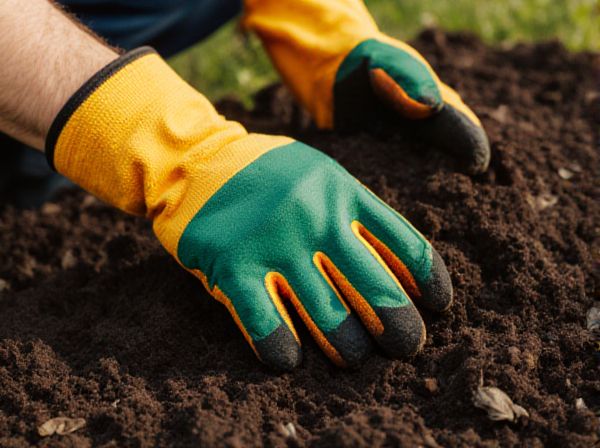
Mulching vs Aerating Illustration
Mulching enhances soil moisture retention and temperature regulation by providing a protective organic layer that decomposes to enrich the soil with nutrients. Aerating improves soil structure by creating small holes that allow air, water, and nutrients to penetrate deeper roots, promoting healthier plant growth. Combining mulching and aerating can significantly boost soil fertility and plant resilience by balancing surface protection with improved underground conditions.
Table of Comparison
| Feature | Mulching | Aerating |
|---|---|---|
| Purpose | Retains soil moisture, suppresses weeds, enriches soil organic matter | Improves soil aeration, reduces compaction, enhances root growth |
| Process | Applying organic or inorganic material on soil surface | Removing small soil plugs or creating holes in soil |
| Benefits | Water conservation, temperature regulation, nutrient addition | Better water infiltration, oxygen supply, nutrient uptake |
| Best for | Gardens, flower beds, vegetable patches | Lawns, compacted soil areas, heavy clay soils |
| Frequency | Annually or as needed depending on mulch material | Once or twice a year, especially in growing season |
| Soil Impact | Improves soil structure and organic content on surface | Enhances deeper soil aeration and root zone health |
Introduction: Understanding Mulching and Aerating
Mulching involves covering soil with organic or inorganic materials to retain moisture, regulate temperature, and suppress weeds, enhancing soil health and plant growth. Aerating is the process of perforating the soil with small holes to improve air, water, and nutrient penetration, which promotes root development and reduces soil compaction. Both techniques play crucial roles in sustainable soil management by optimizing conditions for microbial activity and plant vitality.
What is Mulching?
Mulching involves covering the soil surface with organic or inorganic materials such as wood chips, straw, or plastic sheeting to retain moisture, regulate temperature, and suppress weed growth. This practice enhances soil fertility by slowly decomposing organic mulch, which adds essential nutrients and improves soil structure. Mulching also protects soil from erosion and helps maintain a consistent environment for plant roots.
What is Aerating?
Aerating is the process of perforating the soil with small holes to allow air, water, and nutrients to penetrate the grass roots, promoting healthier lawn growth. It helps reduce soil compaction, improves drainage, and enhances root development. Unlike mulching, which adds organic material to the soil surface, aerating directly modifies soil structure to boost microbial activity and nutrient absorption.
Benefits of Mulching for Garden Soil
Mulching improves garden soil by retaining moisture, reducing evaporation, and suppressing weed growth, which conserves essential nutrients. It enhances soil structure through organic matter decomposition, promoting beneficial microbial activity and increasing nutrient availability. Mulching also moderates soil temperature, protecting plant roots from extreme heat and frost damage.
Benefits of Aerating for Healthy Roots
Aerating soil enhances root health by increasing oxygen flow and improving water absorption, which promotes robust root development. This process reduces soil compaction, allowing roots to spread more easily and access essential nutrients. Compared to mulching, aerating directly stimulates root growth and strengthens the plant's overall resilience.
Mulching vs Aerating: Key Differences
Mulching improves soil moisture retention, temperature regulation, and weed suppression by adding organic or inorganic material on the soil surface, enhancing nutrient levels as it decomposes. Aerating involves perforating the soil with small holes to alleviate compaction, improve air circulation, and promote root growth by increasing oxygen availability. While mulching primarily enhances soil fertility and conserves moisture, aerating directly addresses soil compaction and oxygen diffusion to optimize plant health.
When to Mulch and When to Aerate
Mulching is most effective during spring and fall to conserve soil moisture, regulate temperature, and suppress weed growth, especially around plants and in garden beds. Aerating is best performed in early fall or spring when soil compaction is high, improving oxygen, water, and nutrient penetration to grassroots for healthier lawn development. Timing these practices according to seasonal soil conditions maximizes plant health and soil structure.
Common Mistakes in Mulching and Aerating
Common mistakes in mulching include applying layers that are too thick, which can suffocate roots and promote fungal growth, and using improper materials that may introduce pests or diseases. Aerating errors often stem from aerating too frequently or when the soil is excessively wet, leading to compaction and poor seedbed preparation. Proper timing, material selection, and technique are essential to optimize soil health and plant growth.
Choosing the Right Method for Your Soil Type
Choosing the right soil improvement method depends on soil type and condition; mulching excels in improving moisture retention and organic content for sandy and loamy soils, while aerating is essential for compacted clay soils to enhance air and water movement. Mulching adds a protective layer that reduces erosion and supports beneficial microbial activity, whereas aeration creates channels that facilitate root growth and nutrient absorption. Understanding soil texture and compaction levels guides effective application, ensuring optimal plant health and soil structure.
Sustainable Practices in Mulching and Aerating
Sustainable mulching utilizes organic materials such as wood chips, straw, or compost to enhance soil moisture retention, suppress weeds, and enrich soil nutrients, promoting long-term soil health. Aerating involves perforating the soil to improve oxygen exchange and root growth while minimizing soil compaction, which supports enhanced microbial activity and water infiltration. Combining these practices optimizes soil structure and fertility, fostering resilient ecosystems and reducing reliance on chemical fertilizers and excessive irrigation.
Mulching vs Aerating Infographic

 gardendif.com
gardendif.com